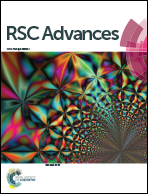Excellent properties and extrusion foaming behavior of PPC/PS/PTFE composites with an in situ fibrillated PTFE nanofibrillar network
Abstract
In this work, we compounded polystyrene (PS) and polytetrafluoroethylene (PTFE) with poly(propylene carbonate) (PPC) via a triple-screw extruder to prepare multiphase composites that possess special properties and to improve the extrusion foaming ability of PPC. It was found that PS was immiscible with PPC and formed a dispersion phase, and PTFE was in situ fibrillated into the nanofibrillar network within the PPC/PS matrix. The introduction of rigid PS domains and PTFE nanofibrils showed remarkable effects on the properties of PPC. Compared with neat PPC, the PPC/PS/PTFE composites had a 12 °C higher glass transition temperature, 292% higher storage modulus in the glassy state characterized by dynamic mechanical analysis, and 1576% higher initial viscosity. Moreover, the physical network formed by PTFE nanofibrils effectively prevented the shear-thinning behavior of the polymer matrix. A significant influence of PTFE on the cell morphology was found in the extrusion foaming process. The cell density of PPC/PS/PTFE foams was four orders of magnitude higher than PPC foams. The compressive modulus and strength of the foamed PPC/PS/PTFE composites were 58 and 34 times higher than that of PPC foams, respectively. The great improvement in the mechanical performance was attributed to the synergistic effects of the enhanced CO2 affinity, the heterogeneous nucleation effect, and the changes in system melt viscosity.


 Please wait while we load your content...
Please wait while we load your content...